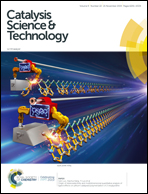Copper on the inner surface of mesoporous TiO2 hollow spheres: a highly selective photocatalyst for partial oxidation of methanol to methyl formate†
Abstract
To raise the methyl formate (MF) selectivity at high methanol conversion is one of the most challenging topics for photocatalytic partial oxidation of methanol to MF. This work addresses the enhancement of the MF selectivity and methanol conversion by designing a new structure of Cu@TiO2 double layered hollow spheres with copper species dispersed on the inner surface of the mesoporous titania shell. We found that the new structure exhibited excellent MF selectivity at high methanol conversion for photocatalytic oxidation of methanol. The photocatalytic performance showed a close relation to its specific structure. The porous titania shell supplied sufficient surface areas for methanol chemisorption. The inner copper layer played important roles in accepting photoexcited electrons from the titania layer. Oxygen molecules chemisorbed on the negatively charged copper surfaces dissociated into active oxygen species and spilled to fill the oxygen vacancies on the titania layer. The pores on the titania shell were beneficial to oxygen inward diffusion, but methanol molecules were blocked from contact with the active oxygen species around the inner copper nanoparticles because of methanol molecules reacting with the surface hydroxyls at the opening of the pores as well as the refinement of the pore size, avoiding deep oxidation. The MF selectivity was proportional to the amount of surface hydroxyls. The light intensity was proportional to methanol conversion but of no relevance to the MF selectivity. The oxidation of methoxy to formaldehyde had a strong relation with light intensity and was the rate-determining step of the reaction, while the coupling reaction between methoxy and formaldehyde had a close relation to the reaction temperature. The catalyst had an induction period during which CuO was reduced to metallic Cu. The highest MF selectivity could be obtained at the stoichiometric ratio of methanol to oxygen, and the methanol conversion increased but the MF selectivity sharply deceased with the increase of oxygen partial pressure. The structure can be controlled by modulating the preparation parameters. This study may contribute to the design of new catalytic systems and provide an applicable green route to MF synthesis.

- This article is part of the themed collection: 2019 Catalysis Science & Technology HOT Articles


 Please wait while we load your content...
Please wait while we load your content...